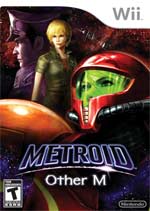Metroid is an odd series when you think about it. It has one of the most recognizable video game characters in Samus, and yet, before playing Metroid: Other M, I can honestly say the only things I knew about her was that she wears a suit and she is indeed a she.
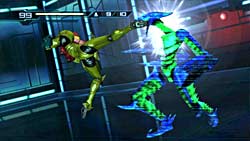
This may be because I only played the 2D platforming Metroids, steering clear of the first-person shooter (FPS) outings, as they didn’t have the same appeal. Either way, Metroid: Other M goes out of its way to showcase Samus not only as a suit of armor bent on destroying enemies, but as a person, with feelings, thoughts, and a history. Whether this works or not is up to individual interpretation, however, when comparing Samus in this title to my previous knowledge of and experience with her, I have to say this game does a good job of humanizing Samus and expanding the universe in which she exists.
The story of Metroid: Other M takes place directly following the events of Super Metroid. After Samus was saved by the baby Metroid’s sacrifice, she took some time off in order to recover. After she had finished healing, all the while continually thinking about the baby Metroid’s death, she receives a distress call nicknamed Baby’s Cry which leads to her a Bottle Ship. Aboard this ship she meets up with some Galactic Federation Army folks from her past who are also there to investigate the distress call. As you can probably imagine, something bad is going on aboard the ship, causing Samus and her past acquaintances to team up in order to get to the bottom of it.
The setting for the game is a bit of a copout, but it works incredibly well. One would think that being aboard a ship would make the game an endless series of metallic rooms and corridors. However, the Bottle Ship is capable of simulating different terrains and climates, making it the perfect setting for a game that wishes to have a large variety of backdrops. Sure, there are still plenty of metallic rooms and corridors, but there are also rain-drenched forests, barren deserts, and even lava fields. The large variety of environments is definitely welcome, as each generally presents its own obstacles, such as the heat from the lava continually damaging Samus when in close proximity.
However, this leads me to one of my biggest disappointments with the game. While the Metroid series typically has you beginning the game underpowered, with few abilities, and gradually reclaiming them throughout the course of the game, it is handled poorly in Other M. Most of the time, your lack of powers is explained by saying your suit has been damaged or something else somewhat believable, however, in Other M, you have all of your abilities to start with but can’t use them until the Commanding Officer of the Galactic Federation authorizes them. Seriously, would you continue to take damage from heat if you had the ability to stop it, even if it hadn’t been authorized yet? Nope, and there are several instances in the Other M where you’ll need an ability but the game won’t give it to you until you’ve been tortured a bit first. Still, this setup will be quite familiar to fans of the series.
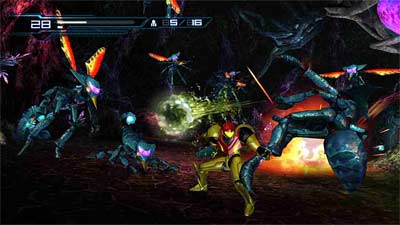
As I stated earlier, I wasn’t really a fan of the FPS Metroids, which has left me without a proper Metroid game to play for quite some time now. Thankfully, Other M is essentially a love letter to fans like me, taking the Metroid series back to its traditional formula. While not strictly a 2D side-scroller, the majority of the game maintains that feel. The camera follows Samus, generally giving you a wide view from the side but can change depending on the situation. When walls get in the way, they simply become transparent, giving the player a decent view the majority of the time. There can be some issues where an enemy will get behind you, making you shoot off screen to engage them, or some objects will still manage to obstruct your view, however, for the most part, the camera works well.
In an odd, but not unexpected move, you’ll play Other M using only the Wii Remote. Holding the controller as you would an NES pad, you’ll have the ability to direct Samus with the D-pad, jumping and shooting with the buttons. This works much as you would expect, almost exactly as it would on the NES or SNES. However, due to the three-dimensional nature of the game, when you fire your weapon, your shots will generally seek out the closest enemy to where you are aiming. Unfortunately, while this works much of the time, you’ll also frequently find yourself questioning why your shot didn’t go towards the enemy you were intending it for.
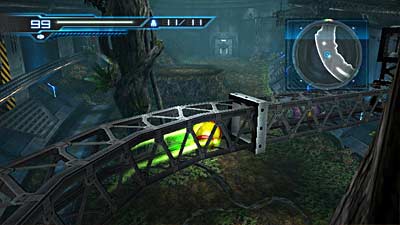
However, things start to get dicey when Other M throws in a curve ball. While a majority of the game will be played in this traditional fashion, the game will occasionally call upon you to point the controller at the screen for a first-person view.
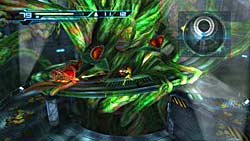
You’ll need to do this to specifically aim your weapon, to shoot missiles, and to investigate some scenes. While this works fine as an exploratory control, holding down the B trigger to allow the camera to move and shooting with the A button if necessary, when it is required during a fight, it gets frustrating. When you go into first-person aiming, not only do you have to awkwardly transition the way you’re holding the controller, you are also unable to move. This typically spells disaster, as you are likely to take a beating while fumbling with the controller and then trying to shoot, not to mention the problems that arise from having to hold the B trigger to move the camera when that is also what is required to lock onto enemies.
Awkward controller issues continue when trying to heal Samus. While she can get fully recharged at save points found throughout the Bottle Ship, sometimes you’ll desperately need health or missiles. In these cases, you’ll need to point the controller towards the ceiling and hold down the A button while you slowly regain health and missiles. I understand the motion, as it mimics what Samus is doing on-screen; however, it comes off as clumsy, given that you’ll occasionally turn into the morph ball instead since it uses the same button. Also, this maneuver is nearly impossible to pull off during combat, meaning that if you need healed during a fight, you might as well take a dive because trying to heal is typically suicide.
Even with these gripes, I found myself completely enjoying Other M. The gameplay is a return to form for the series, although I believe this has to be the fastest Metroid I’ve ever played. For instance, Samus runs so quickly in this game I found myself outrunning the game’s ability to load the environment, resulting in having to wait a few seconds for some doors to open. The more actiony take on Metroid is also a welcomed addition, with Samus being able to dodge attacks and perform cinematic finishing maneuvers on enemies.
While Metroid: Other M isn’t without its flaws, specifically awkward controller transitions and some aiming issues, the entirety of the package is quite good. Not only is this game a return to form for the series, it also brings several new things to the table that help to make it an enjoyable experience. If you’re like me and didn’t necessarily get into the FPS Metroids but enjoyed Samus back in the 8 and 16bit days, you owe it to yourself to check out Other M. Here’s hoping Team Ninja and Nintendo continue to work together for some sequels.
RATING OUT OF 5 RATING DESCRIPTION 4.4 Graphics
While the in-game graphics aren’t quite as impressive as the gorgeous cinematics, Other M looks great. 3.7 Control
Some issues with aiming and awkward transitions between controller positions keep the game’s controls from being flawless. 4.0 Music / Sound FX / Voice Acting
The sound effects and music are great, and the voice acting is good, however, much of Samus’ dialogue seemed flat. 4.4
Play Value
Other M will take you about ten hours to beat or longer if you seek out every missile canister and health upgrade. It even gives you a bonus mission after completion and a theater mode in which to enjoy the game’s cutscenes and small gameplay segments pieced together into a lengthy Metroid: Other M film.
4.3 Overall Rating – Great
Not an average. See Rating legend above for a final score breakdown.
Game Features:
